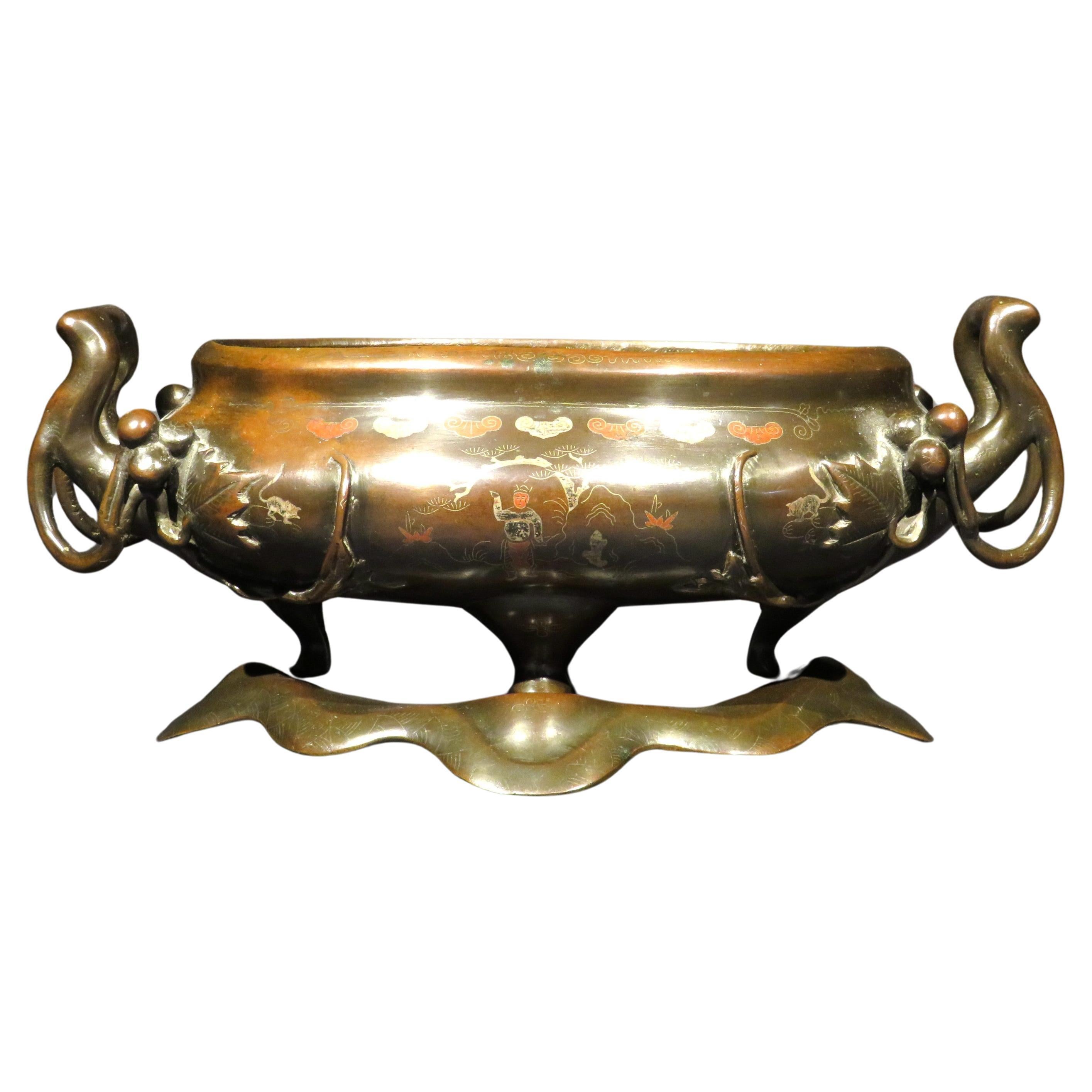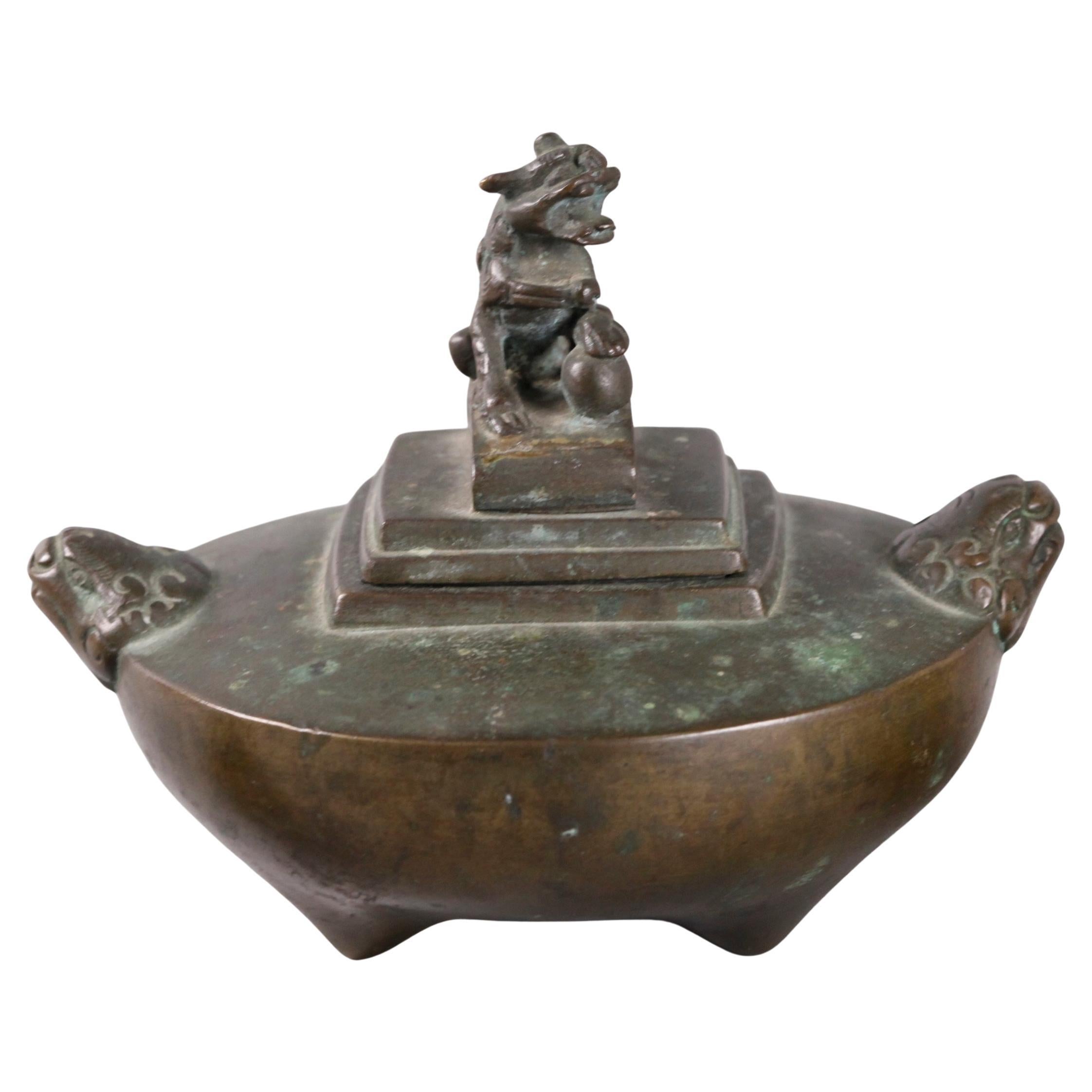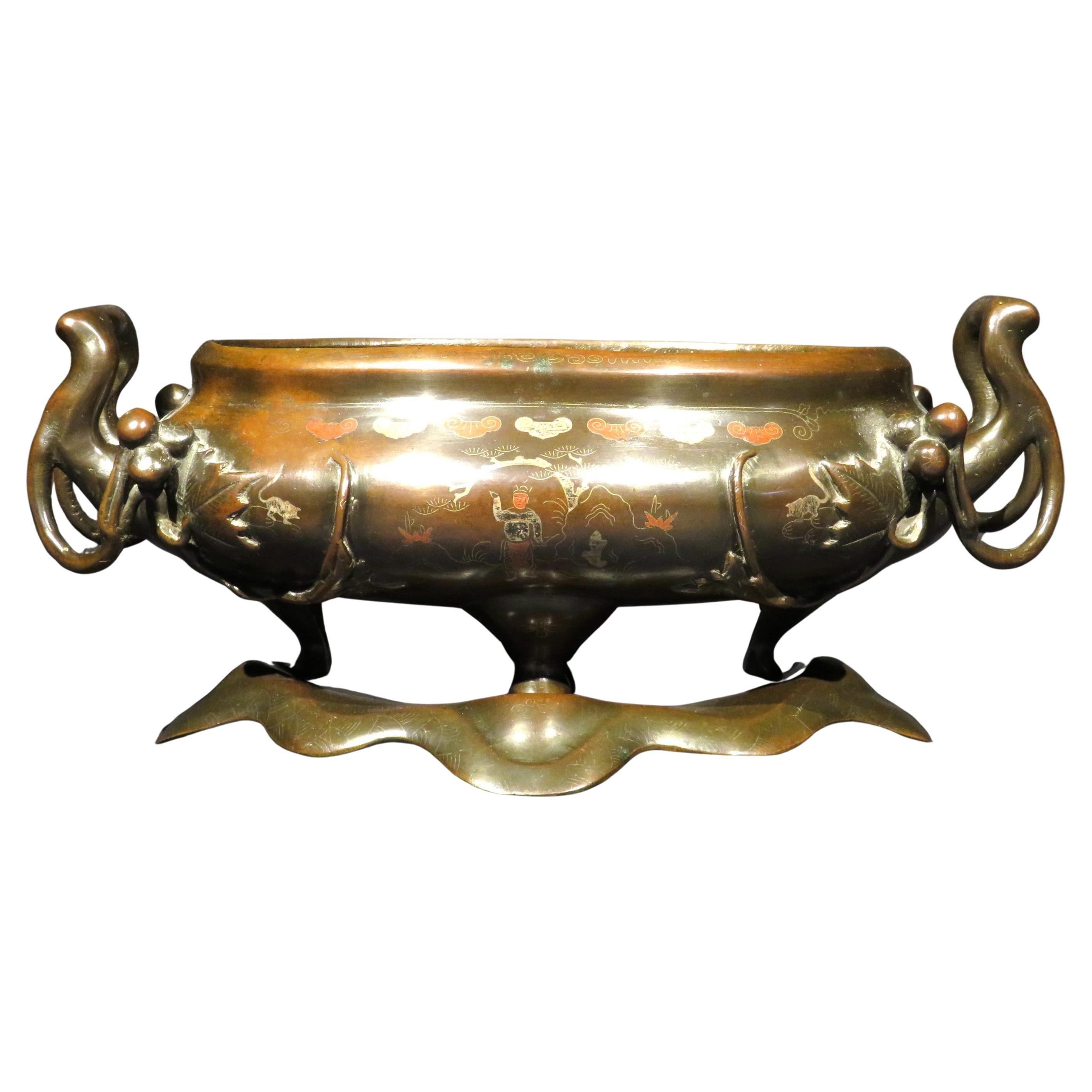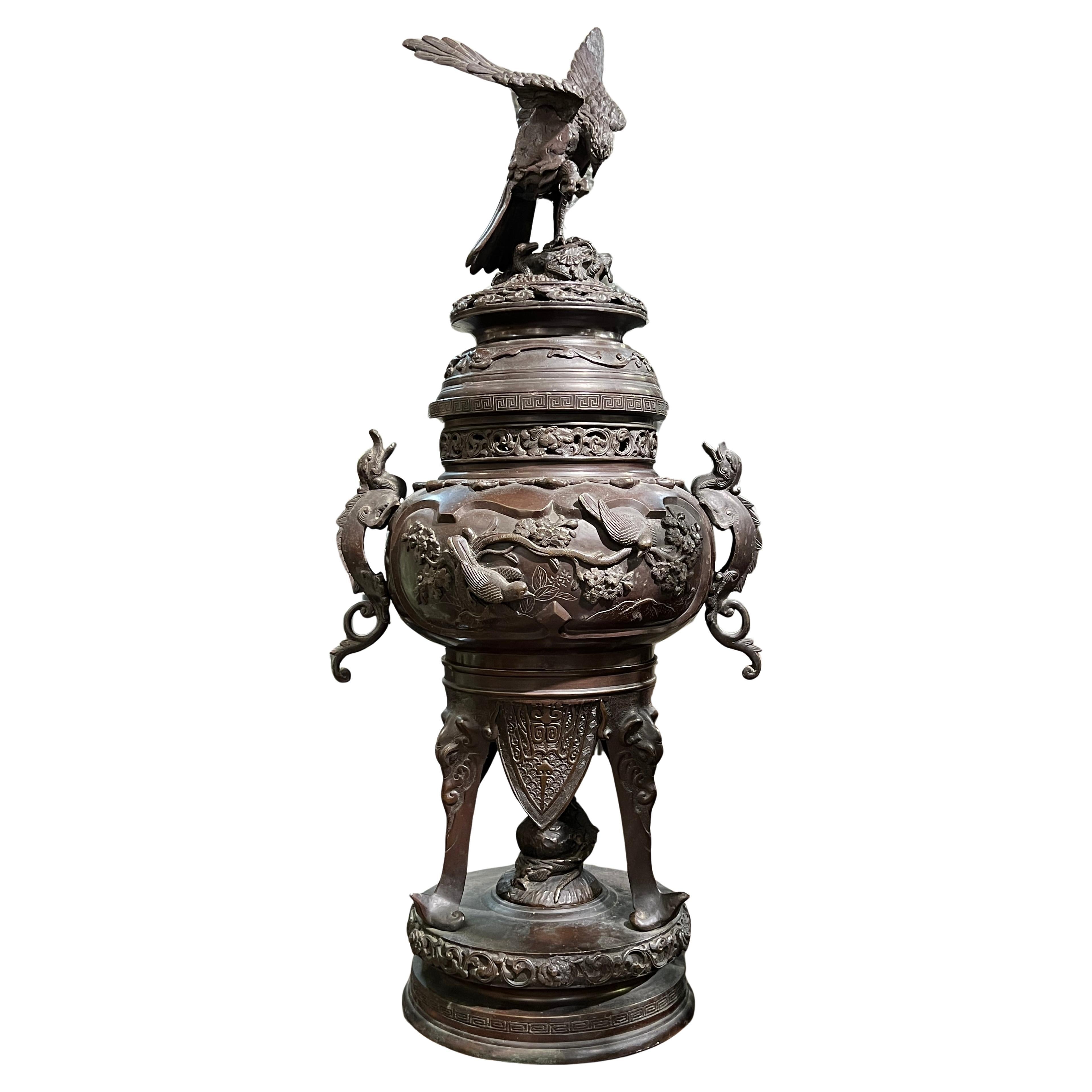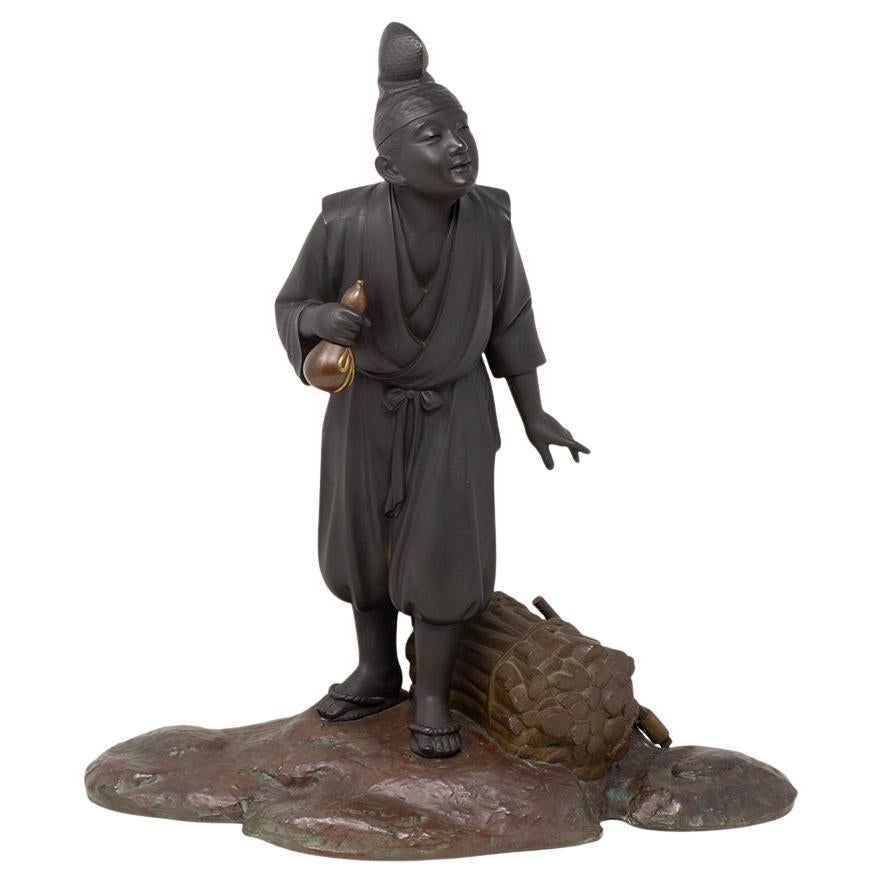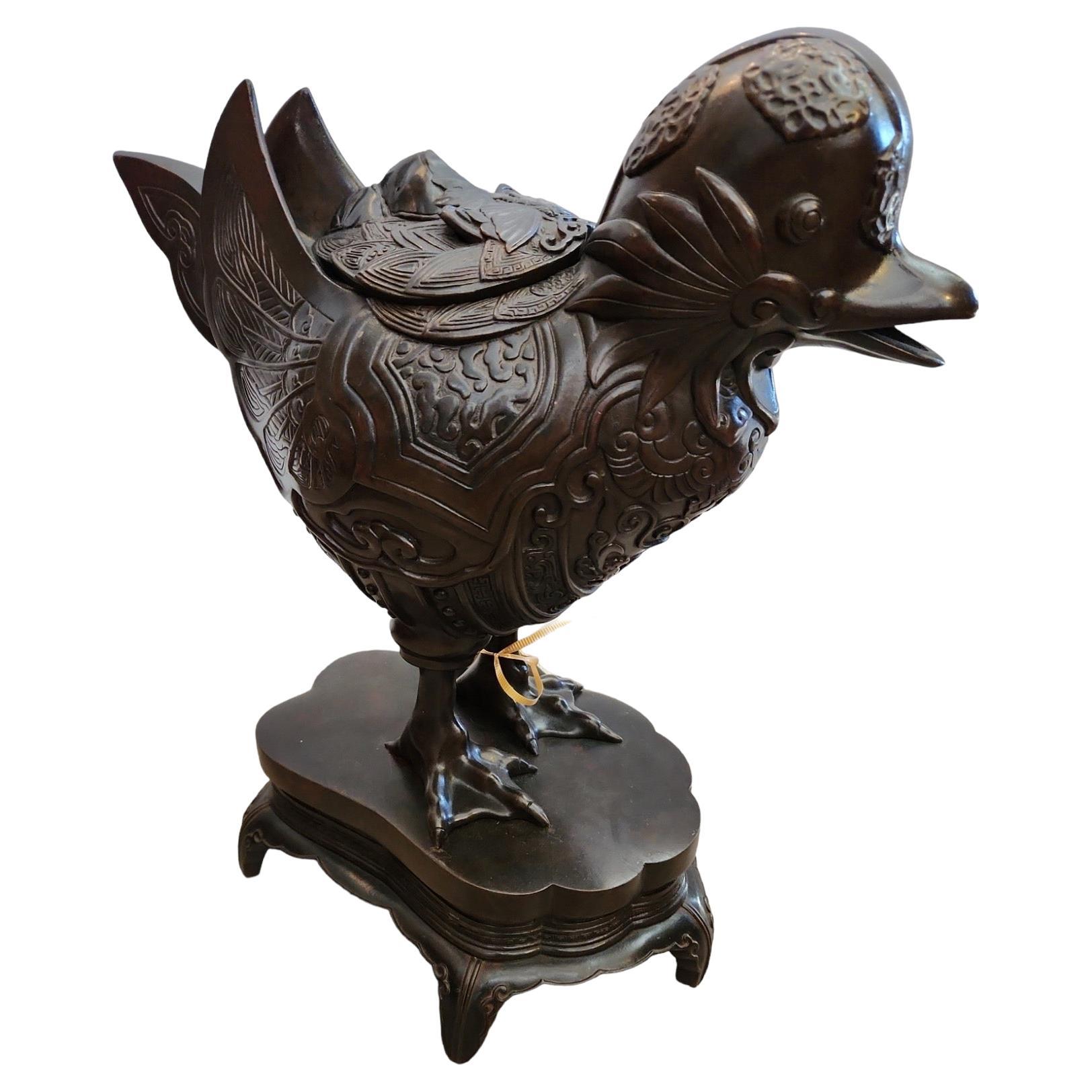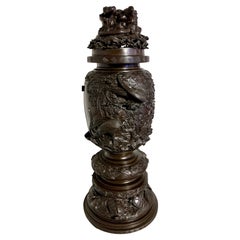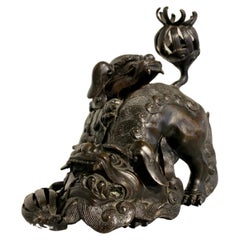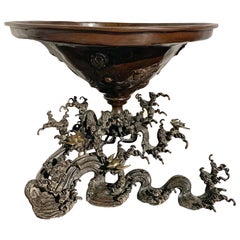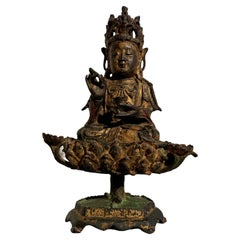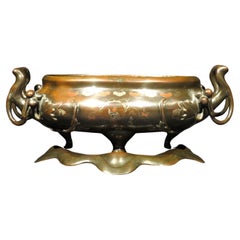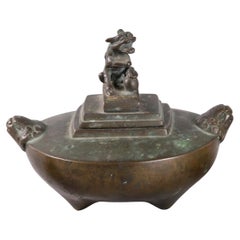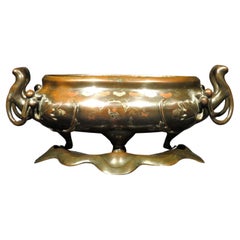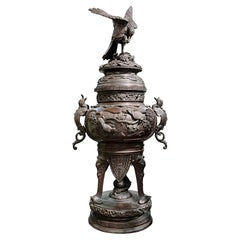Items Similar to Japanese Bronze Water Coupe, Eguchi as Fugen, Edo/Meiji Period, Japan
Want more images or videos?
Request additional images or videos from the seller
1 of 12
Japanese Bronze Water Coupe, Eguchi as Fugen, Edo/Meiji Period, Japan
$1,250
£948.47
€1,084.49
CA$1,745.91
A$1,941.22
CHF 1,013.60
MX$23,629.32
NOK 12,933.04
SEK 12,117.64
DKK 8,093.76
Shipping
Retrieving quote...The 1stDibs Promise:
Authenticity Guarantee,
Money-Back Guarantee,
24-Hour Cancellation
About the Item
A very finely cast Japanese bronze water coupe in the form of the courtesan Eguchi riding an elephant, signed Kazutada, Edo to Meiji Period, mid 19th century, Japan.
The small and elegant bronze water coupe is exquisitely cast to depict a figure of a seated lady reading poetry upon the back of a large recumbent elephant. This image depicts the Courtesan of Eguchi as Fugen Bosatsu. A three character inscription to the base reading "Kazutada Saku" (made by Kazutada).
The elephant is portrayed in a recumbent position, its legs tucked under, and head and tail wrapped around its prodigious body, trunk extended. A coy smile dances across the beast's face, its eyes exuding intelligence and kindness. The underside of the toes are especially detailed.
The female figure seated upon the back of the elephant serves as the lid of the water coupe. She is seated in a relaxed pose, with one knee raised, and dressed in the robes of a courtesan, her long hair tied back. She reads a scroll of poetry. This figure can be identified as the Courtesan of Eguchi, a 12th century prostitute named Tae living in the town of Eguchi, who famously had a conversation with the traveling monk Saigyo after he had asked for lodging within her brothel.
In the Edo period, it was popular to conflate or parody Tae as Fugen Bosatsu (the Bodhisattva Samantabhadra, the Bodhisattva of Virtue). The seeminglyincongruous pairing of a prostitute and the Bodhisattva of Virtue served as a commentary on the nature of perception and reality, and the ideas of virtue and vice.
- Dimensions:Height: 3 in (7.62 cm)Width: 3.63 in (9.23 cm)Depth: 2.25 in (5.72 cm)
- Style:Meiji (Of the Period)
- Materials and Techniques:
- Place of Origin:
- Period:
- Date of Manufacture:mid 19th Century
- Condition:Wear consistent with age and use. Minor fading. In overall very good condition. With some minor wear and loss to the lacquer finish. Minor wear to the bronze. Some dirt and dust accretions to the recesses. Please see photos.
- Seller Location:Austin, TX
- Reference Number:1stDibs: LU894739168392
About the Seller
5.0
Platinum Seller
Premium sellers with a 4.7+ rating and 24-hour response times
Established in 2001
1stDibs seller since 2010
345 sales on 1stDibs
Typical response time: <1 hour
- ShippingRetrieving quote...Shipping from: Austin, TX
- Return Policy
Authenticity Guarantee
In the unlikely event there’s an issue with an item’s authenticity, contact us within 1 year for a full refund. DetailsMoney-Back Guarantee
If your item is not as described, is damaged in transit, or does not arrive, contact us within 7 days for a full refund. Details24-Hour Cancellation
You have a 24-hour grace period in which to reconsider your purchase, with no questions asked.Vetted Professional Sellers
Our world-class sellers must adhere to strict standards for service and quality, maintaining the integrity of our listings.Price-Match Guarantee
If you find that a seller listed the same item for a lower price elsewhere, we’ll match it.Trusted Global Delivery
Our best-in-class carrier network provides specialized shipping options worldwide, including custom delivery.More From This Seller
View AllLarge Japanese Bronze Koro Incense Burner, Meiji Period, 19th Century, Japan
Located in Austin, TX
A large and fantastic Japanese cast bronze incense burner, koro, with high relief design, Meiji period, late 19th century, Japan.
The large and tall koro cast in extremely high re...
Category
Antique Late 19th Century Japanese Meiji Metalwork
Materials
Bronze
Chinese Bronze Fighting Foo Lions Censer, Qing Dynasty, Late 19th Century, China
Located in Austin, TX
A fantastic Chinese cast bronze censer in the form of two Buddhistic lions play fighting, late Qing Dynasty, late 19th century, China.
The censer formed as a pair of Buddhistic li...
Category
Antique Early 1900s Chinese Qing Sculptures and Carvings
Materials
Bronze
Japanese Bronze Usubata with Waves and Plovers, Edo Period, Mid-19th Century
Located in Austin, TX
An impressive Japanese cast bronze usubata, vessel for ikebana, in the form of a large conical vessel being supported by crashing waves and flying chidori. Edo Period, mid-19th centu...
Category
Antique Mid-19th Century Japanese Edo Metalwork
Materials
Bronze
Chinese Ming Dynasty Bronze Nanhai Guanyin, 16th/17th Century, China
Located in Austin, TX
A decidingly charming Chinese polychromed and gilt cast bronze figure of Nanhai Guanyin, Guanyin of the South Sea, Ming Dynasty, 16th/17th century, China.
Guanyin, the bodhisattva of compassion, is portrayed here as a beatific figure seated upon a raised lotus pedestal over waves. Guanyin is dressed in heavy robes, and wears an elaborate headdress. The small figure of Amitabha Buddha in the headdress positively identifies this figure as Guanyin.
Guanyin rests one hand in his lap, holding a cup of pure water said to be able to alleviate all suffering. His other hand is raised, holding a willow branch which is used to sprinkle the healing waters.
The two lotus blossoms to either side of Guanyin would originally have supported figures of the acolytes...
Category
Antique Early 1600s Chinese Ming Sculptures and Carvings
Materials
Bronze
Japanese Parcel Gilt Copper Hibachi, Edo Period, 18th Century, Japan
Located in Austin, TX
A sublime Japanese parcel gilt copper hand warmer, hibachi, with chrysanthemum design, Edo Period, 18th century, Japan.
The hand warmer, called a...
Category
Antique 18th Century Japanese Edo Metalwork
Materials
Copper
Japanese Edo Period Lacquer and Mother-of-Pearl Embellished Stoneware Koro
Located in Austin, TX
A highly unusual Japanese crackle glazed koro (incense burner or censer), lacquered and inlaid with mother-of-pearl embellishment, signed Gyokusen, Ed...
Category
Antique 19th Century Japanese Edo Scholar's Objects
Materials
Copper
You May Also Like
A Very Fine Japanese Mixed Metal Bronze Censer on Stand, Taisho Period
Located in Ottawa, Ontario
A very fine Taisho Period bronze censer of bellied oval form, richly decorated overall with hand enamelled and 'shibuichi' & 'shakudo' motifs, depicting geometric designs, pine trees...
Category
Early 20th Century Japanese Meiji Scholar's Objects
Materials
Bronze
Chinese bronze censer, 19th c.
Located in New York, NY
cover surmounted by a foo lion
Category
Antique Late 19th Century Chinese Metalwork
Materials
Bronze
A Very Fine Japanese Mixed Metal Bronze Suiban / Planter on Stand, Taisho Period
Located in Ottawa, Ontario
A very fine Japanese bronze Suiban (planter) of bellied oval form, richly decorated overall with hand enamelled and 'shibuichi' & 'shakudo' motifs, depicting geometric designs, pine ...
Category
Early 20th Century Japanese Meiji Scholar's Objects
Materials
Bronze
19th Century Japanese Bronze Censer / Koro
Located in New York, NY
This large antique (late 19th century) patinated bronze censer (incense burner) from the Meiji period measures 32 1/2 by 14 by 10 inches and features finely cast details including fi...
Category
Antique Late 19th Century Japanese Meiji Metalwork
Materials
Bronze
Japanese Bronze Okimono Sculpture by Yamamoto Kozan
Located in Newark, England
YOUNG MAN WOOD CUTTING
From our Japanese collection, we are pleased to offer this Japanese Bronze Okimono by Yamamoto Kozan. The Japanese Bronze Sculpture cast in Bronze with a natu...
Category
Early 20th Century Japanese Meiji Sculptures and Carvings
Materials
Bronze
19th Century Chinese Bronze Incense Vessel
Located in Los Angeles, CA
Beautifully chased 19th century bronze. In three parts. Great as just a table sculpture.
Category
Antique 19th Century Chinese Chinese Export Animal Sculptures
Materials
Bronze
More Ways To Browse
Midcentury Japanese Art
Japanese Head
Antique Watering Can
Watering Can Mid Century
Antique Tie Back
Edo Period Gold
Meiji Scroll
Japanese Monk
Japanese Elephant
Meiji Figure
Large Gold Elephant
Japanese Trunk
Edo Scroll
Edo Period Bronze
Elephant Figure
Edo Period Scroll
Japanese Bronze Figure
Japanese Seated Figure
